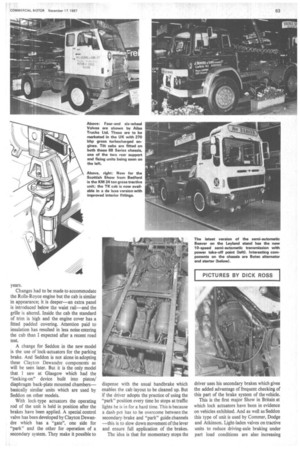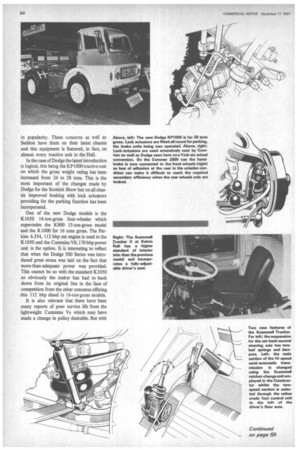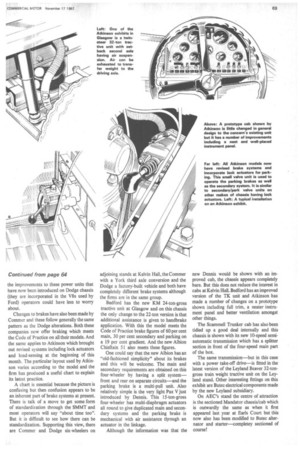GLASGOW PACKS 'EM IN
Page 64

Page 65

Page 66

Page 71

Page 72

If you've noticed an error in this article please click here to report it so we can fix it.
Considerable technical interest at Kelvin Hall—but not much room to show off new models
By A. J. P. Wilding, AMIMechE, MIRTE
ANY WHO SAY the Scottish Motor Show is of relatively minor importance in the commercial vehicle calendar are proved completely wrong by this year's show at Kelvin Hall. New models, improved cabs and improved brakes are among the most interesting features.
Another point is that with the Earls Court Show held every two years, Kelvin Hall provides the opportunity for an annual stock-taking of design and trends in Britain. The only bad thing is that there is not much room at Kelvin Hall to show off the commercial vehicles adequately.
Study of specifications of new models at Glasgow shows pretty clearly where we are going. But in my view in certain respects the direction is not absolutely perfect. Higher standard and more comfortable cabs can do nothing but good in making the driver safer and putting him in the right frame of mind to treat the vehicle with consideration.
But I would like to see more use of power steering on the heavy tractive units—this is not always standard, even where the axle loading is around six tons. And against impressions of trends to higher-power vehicles some models will be open to criticism for having too little power—and possibly to abuse also as a result. And while many manufacturers are making strong publicity of better brakes some attempt at standardization of system design is long overdue.
A number of tractive units feature in the list of new models, among them the new Seddon 32:four which has a Rolls-Royce 220 bhp gross engine as standard. The drive is through a David Brown six-speed overdrive gearbox to a new 13-ton capacity rear axle designed and produced by Seddon. This unit has 4 to 1 secondary reduction in the hubs, overall ratio being 6.12 to I.
The 32:four has been designed for use at up to 38 tons gross train weight although limited (and plated) to 32 tons in Britain. The front axle has a rating of six tons and when I had the chance of driving the model solo shortly before it went on the stand I got the feeling that power steering would have been desirable.
Even solo, sonic effort was required to drive the unit but then I had just conic off driving an artie with very well designed and light power steering. The cab on the 32:four is based on the unit used on other Seddon chassis introduced in the past two or three years.
Changes had to be made to accommodate the Rolls-Royce engine but the cab is similar in appearance; it is deeper—an extra panel is introduced below the waist rail—and the grille is altered. Inside the cab the standard of trim is high and the engine cover has a fitted padded covering. Attention paid to insulation has resulted in less noise entering the cab than I expected after a recent road test.
A change for Seddon in the new model is the use of lock-actuators for the parking brake. And Seddon is not alone in adopting these Clayton Dewandre components as will be seen later. But it is the only model that I saw at Glasgow which had the "locking-on" device built into piston/ diaphragm back-plate mounted chambers— basically similar units which are used by Seddon on other models.
With lock-type actuators the operating rod of the unit is held in position after the brakes have been applied. A special control valve has been developed by Clayton Dewandre which has a "gate", one side for "park" and the other for operation of a secondary system. They make it possible to dispense with the usual handbrake which enables the cab layout to be cleaned up. But if the driver adopts the practice of using the "park" position every time he stops at traffic lights he is in for a hard time. This is because a dash-pot has to be overcome between the secondary-brake and "park" guide channels —this is to slow down movement of the lever and ensure full application of the brakes.
The idea is that for momentary stops the driver uses his secondary brakes which gives the added advantage of frequent checking of this part of the brake system of the vehicle.
This is the first major Show in Britain at which lock actuators have been in evidence on vehicles exhibited. And as well as Seddon this type of unit is used by Commer, Dodge and Atkinson. Light-laden valves on tractive units to reduce driving-axle braking under part load conditions are also increasing in popularity. These concerns as well as Seddon have them on their latest chassis and this equipment is featured, in fact, on almost every tractive unit in the Hall.
In the case of Dodge the latest introduction is logical, this being the KP1000 tractive unit on which the gross weight rating has been increased from 24 to 28 tons. This is the most important of the changes made by Dodge for the Scottish Show but on all chassis improved braking with lock actuators providing for the parking function has been incorporated.
One of the new Dodge models is the K1050 16-ton-gross four-wheeler which supercedes the K900 15-ton-gross model and the K1000 for 16 tons gross. The Perkins 6.354, 112 bhp net engine is used in the K1050 and the Cummins V8, 170 bhp power unit is the option. It is interesting to reflect that when the Dodge 500 Series was introduced great stress was laid on the fact that more-than-adequate power was provided. This cannot be so with the standard K1050 so obviously the maker has had to back down from its original line in the face of competition from the other concerns offering this 112 bhp diesel in 16-ton-gross models.
It is also relevant that there have been many reports of poor service life from the lightweight Cummins Vs which may have made a change in policy desirable. But with
the improvements to these power units that have now been introduced on Dodge chassis (they are incorporated in the V8s used by Ford) operators could have less to worry about.
Changes to brakes have also been made by Commer and these follow generally the same pattern as the Dodge alterations. Both these companies now offer braking which meets the Code of Practice on all their models. And the same applies to Atkinson which brought out revised systems including lock actuators and load-sensing at the beginning of this month. The particular layout used by Atkinson varies according to the model and the firm has produced a useful chart to explain its latest practice.
A chart is essential because the picture is confusing but then confusion appears to be an inherent part of brake systems at present. There is talk of a move to get some form of standardization through the SMMT and most operators will say "about time too". But it is difficult to see how there can be standardization. Supporting this view, there are Commer and Dodge six-wheelers on adjoining stands at Kelvin Hall, the Commer with a York third axle conversion and the Dodge a factory-built vehicle and both have completely different brake systems although the firms are in the same group.
Bedford has the new KM 24-ton-gross tractive unit at Glasgow and on this chassis the only change to the 22-ton version is that additional assistance is given to handbrake application. With this the model meets the Code of Practice brake figures of 60 per cent main, 30 per cent secondary and parking on a 19 per cent gradient. And the new Albion Chieftain 51 also meets these figures.
One could say that the new Albion has an "old-fashioned simplicity" about its brakes and this will be welcome. The main and secondary requirements are obtained on this four-wheeler by having a split system— front and rear on separate circuits—and the parking brake is a multi-pull unit. Also relatively simple is the very light Pax V just introduced by Dennis. This 15-ton-gross four-wheeler has multi-diaphragm actuators all round to give duplicated main and secondary systems and the parking brake is mechanical with air assistance through an actuator in the linkage.
Although the information was that the new Dennis would be shown with an improved cab, the chassis appears completely bare. But this does not reduce the interest in cabs at Kelvin Hall. Bedford has an improved version of the TK unit and Atkinson has made a number of changes on a prototype shown including full trim, a neater instrument panel and better ventilation amongst other things.
The Scammell Trunker cab has also been tidied up a good deal internally and this chassis is shown with its new 10-speed semiautomatic transmission which has a splitter section in front of the four-speed main part of the box.
The same transmission—but in this case with a power take-off drive—is fitted in the latest version of the Leyland Beaver 32-tongross train weight tractive unit on the Leyland stand. Other interesting fittings on this exhibit are Butec electrical components made by the new Leyland subsidiary.
On AEC's stand the centre of attraction is the sectioned Mandator chassis/cab which is outwardly the same as when it first appeared last year at Earls Court but this now also has been modified to Butec alternator and starter—completey sectioned of course! Detail changes on chassis at Kelvin Hall include a Guy Big J with Gardner 6LXB which has a small oil cooler mounted in front of the radiator and as a result a revised front grille; this is a standard fitting by the firm with the LXB.
Also of interest is the new BMC FM range which includes three chassis—for 4.2, 5.5 and 7 tons gross which are in effect versions of the FG with their 3.8-litre diesel engines mounted further forward and having a reinforced plastics "snout" at the front of the cab.
The FM allows a better across-cab access and in a van version to be seen in Glasgow, better access to the body from the driving seat.
This year the Glasgow Show has a decidedly Continental flavour. There are the Volvo F88 models shown by Ailsa Trucks Ltd., for the first time in Britain and also making its first appearance in the UK is the Mercedes-Benz 1317 tractive unit. Smaller vehicles from across the Channel are Fiat light vans and a DAF van and pick-up.
The Volvos are the highest-powered haulage models at Kelvin Hall with 270 bhp engines. As reported in last week's issue a run was made to Glasgow in a similar chassis and the standard of comfort for the driver is very high. The same can be said for the Mercedes-Benz LPS 1317 which is now to be marketed in Britain for the first time. It has the latest design flat-front cab and a 175 bhp net engine and will be marketed for 24/28 tons gross train weight.
As usual at Glasgow a number of firms put on their own shows around the city. The Mercedes-Benz Scottish agent, Northern Truck Distributors has a display close to Kelvin Hall where the LPS2023 32/38 tons g.t.w. tractive unit introduced at Frankfurt is displayed. Millburn Motors is also putting on a big display of Leyland Group and Ford vehicles at its new premises at Glasgow and SNIT has many Bedford vehicles on its pre mises including a new KC tractive unit for 9.35 tons gross train weight. This model has Taskers automatic coupling gear.
There is not as much interest in passenger vehicles at Glasgow as there is in trucks— at least as far as chassis are concerned. Both Leyland and Daimler are, however, showing 33ft-long double-deckers—the Atlantean and Fleetline respectively—and on the Seddon stand there is a Pennine IV singledeck chassis which was only introduced this year. This last exhibit has built on it the front end of a body which illustrates the type of entrance that can be provided. AEC's most important p.s.v. exhibit, a Reliance with coil-spring suspension, is outside the hall in order to give demonstrations.
















































































































































